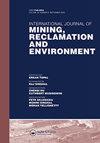土壤质量和种植材料对废石坡地杂交杨树苗根系构型和根系锚固的影响
IF 2.6
3区 工程技术
Q3 ENVIRONMENTAL SCIENCES
International Journal of Mining Reclamation and Environment
Pub Date : 2022-11-15
DOI:10.1080/17480930.2022.2144020
引用次数: 2
摘要
摘要在矿山废石边坡上,根系发育不充分的树木很容易被连根拔起。树木的锚固主要由驱动其与土壤机械相互作用的根系结构决定。本研究的目的是评估土壤质量和不同种植材料对杂交杨树初始种植四年后根系结构和抗剪应力的影响。这项研究是在一个露天金矿进行的。2013年,采用随机完全块体设计,即3个重复块体,在33%的土壤覆盖的废石斜坡上建立了一个杂交杨树种植园 × 3种种植材料 × 2土壤质量。采用侧向牵引试验对杂交杨树的稳定性(抗连根拔)进行了评价。进行了完整的挖掘,以表征其粗根(>4 mm)架构。结果表明,不同处理对连根拔起的最大阻力在7142~89899N之间没有显著差异。经过四个生长季节,侧根数量、平均根径、根生物量、地上生物量和地上茎根比没有受到土壤质量或种植材料的显著影响。本文章由计算机程序翻译,如有差异,请以英文原文为准。
Effect of soil quality and planting material on the root architecture and the root anchorage of young hybrid poplar plantations on waste rock slopes
ABSTRACT On mine waste rock slopes, trees with inadequate root development could be prone to uprooting. The anchorage of trees is mainly determined by the architecture of the root systems that drive their mechanical interactions with the soil. The objective of this study was to evaluate the effects of soil quality and of different planting materials on the architecture and resistance to shear stress of root systems of hybrid poplars four years after they were initially planted. The study was conducted in an open-pit-gold mine. A hybrid poplar plantation was established in 2013 on 33% soil-covered waste rock slopes, using a randomised complete block design, that is, 3 replicated blocks × 3 planting materials × 2 soil qualities. The stability of the hybrid poplars (resistance to uprooting) was evaluated using lateral traction tests. Complete excavations were performed to characterise their coarse root (>4 mm) architecture. Results showed no significant differences between treatments in terms of the maximum resistance force to uprooting, which varied between 7142 and 8989 N. After four growing seasons, no significant effects due to soil quality or planting material were observed in the number of lateral roots, mean root diameter, root biomass, aboveground biomass, and shoot/root ratio.
求助全文
通过发布文献求助,成功后即可免费获取论文全文。
去求助
来源期刊

International Journal of Mining Reclamation and Environment
ENVIRONMENTAL SCIENCES-MINING & MINERAL PROCESSING
CiteScore
5.70
自引率
8.30%
发文量
30
审稿时长
>12 weeks
期刊介绍:
The International Journal of Mining, Reclamation and Environment published research on mining and environmental technology engineering relating to metalliferous deposits, coal, oil sands, and industrial minerals.
We welcome environmental mining research papers that explore:
-Mining environmental impact assessment and permitting-
Mining and processing technologies-
Mining waste management and waste minimization practices in mining-
Mine site closure-
Mining decommissioning and reclamation-
Acid mine drainage.
The International Journal of Mining, Reclamation and Environment welcomes mining research papers that explore:
-Design of surface and underground mines (economics, geotechnical, production scheduling, ventilation)-
Mine planning and optimization-
Mining geostatics-
Mine drilling and blasting technologies-
Mining material handling systems-
Mine equipment
 求助内容:
求助内容: 应助结果提醒方式:
应助结果提醒方式:


